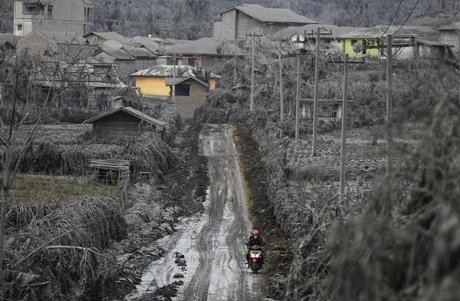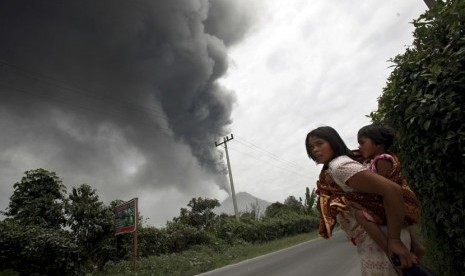NASA Radar Maps the Winter Pace of Iceland's Glaciers
A small part of the Hofsjökull ice hat in Iceland A small part of the
Hofsjökull ice cap in Iceland, which encompasses some glaciers. The fan
at top left is part of a glacier called Múlajökull. Image borrowing:
Caltech
A high-precision radar instrument from NASA's Jet Propulsion lab, Pasadena, Calif., left south California for Iceland today to create comprehensive maps of how glaciers move in the dead of winter. This will help scientists better understand some of the most basic methods engaged in melting glaciers, which are major suppliers to increasing sea levels.
The JPL-developed equipment, which soars on a NASA study airplane, departed from NASA's Dryden airplane Operations Facility in Palmdale, Calif. The trial is directed by assess Simons, a lecturer of geophysics at the California organisation of expertise in Pasadena, and Brent Minchew, a Caltech graduate student.
Simons and Minchew utilised the same airborne equipment in June 2012 to chart the summer flows of two Icelandic ice caps. The ice caps -- large localities of permanent snowfallfall and ice cover -- encompass multiple glaciers raging torrent in distinct directions and at distinct races.
throughout the 2012 campaign, surface ice on the glaciers was dissolving under the summer sun. Meltwater that trickles through the body of a glacier down to the bedrock underneath can leverage the speed at which the glacier flows. By mapping the same ice caps now, in winter, when the exterior remains frozen all day, and then matching the winter and summer velocities, the researchers will be adept to isolate the consequences of meltwater.
"That's a demanding subject," said Minchew. "Our comprehending of the consequences of meltwater on glacier flow is by no means entire. Even the most complicated ice sheet forms likely are not apprehending all of the salient processes."
Using NASA's C-20A airborne research airplane and support crew, the investigators will make four flights from Keflavik worldwide aerodrome beside Reykjavik, Iceland, between Jan. 30 and Feb. 6 throughout the couple of Arctic daylight hours. Each air travel follows accurately the same perplexing route as flown in 2012. The crisscrossing flight legs permit the JPL-developed instrument, called the Uninhabited Aerial Vehicle Synthetic Aperture Radar (UAVSAR), to chart the full span of both ice caps from multiple twists to capture flows in every main heading. The action of the ice between one flight and the next permits scientists to calculate flow races. "The UAVSAR gives us an entire, relentless map of how every location on the ice cap is moving," Simons said.
The two ice caps, called Hofsjökull and Langjökull, are perfect natural laboratories for this trial, according to Simons. They're somewhat uncomplicated and little sufficient that the scientists can readily use the facts and figures from these trials in computer forms of glacier flow without requiring a supercomputer. Langjökull, the bigger of the two, covers about 360 square miles (950 rectangle kilometers); for evaluation, the biggest ice hat in Iceland, Vatnajökull, is more than 3,100 rectangle miles (8,000 rectangle kilometers).
An even stronger motivation, Simons said, is that "we are benefiting from a huge allowance of work on these glaciers that's currently been finished by a group of internationally identified glaciologists in Iceland. The glaciers are in their backyard, and they've been studying them for years. They've currently mapped the ice-rock interface at the base of the glacier, for demonstration. We've had nothing but support and support from them."
For more information on UAVSAR, visit: http://uavsar.jpl.nasa.gov.
Caltech organises JPL for NASA.
NASA monitors Earth's crucial signs from land, air and space with a fleet of satellites and determined airborne and ground-based fact crusades. NASA evolves new ways to observe and study Earth's interconnected natural schemes with long-term facts and figures notes and computer investigation tools to better glimpse how our planet is altering. The bureau shares this exclusive information with the international community and works with institutions in the United States and round the world that contribute to comprehending and protecting our dwelling planet.
For more information about NASA's soil research undertakings in 2014, visit: http://www.nasa.gov
A high-precision radar instrument from NASA's Jet Propulsion lab, Pasadena, Calif., left south California for Iceland today to create comprehensive maps of how glaciers move in the dead of winter. This will help scientists better understand some of the most basic methods engaged in melting glaciers, which are major suppliers to increasing sea levels.
The JPL-developed equipment, which soars on a NASA study airplane, departed from NASA's Dryden airplane Operations Facility in Palmdale, Calif. The trial is directed by assess Simons, a lecturer of geophysics at the California organisation of expertise in Pasadena, and Brent Minchew, a Caltech graduate student.
Simons and Minchew utilised the same airborne equipment in June 2012 to chart the summer flows of two Icelandic ice caps. The ice caps -- large localities of permanent snowfallfall and ice cover -- encompass multiple glaciers raging torrent in distinct directions and at distinct races.
throughout the 2012 campaign, surface ice on the glaciers was dissolving under the summer sun. Meltwater that trickles through the body of a glacier down to the bedrock underneath can leverage the speed at which the glacier flows. By mapping the same ice caps now, in winter, when the exterior remains frozen all day, and then matching the winter and summer velocities, the researchers will be adept to isolate the consequences of meltwater.
"That's a demanding subject," said Minchew. "Our comprehending of the consequences of meltwater on glacier flow is by no means entire. Even the most complicated ice sheet forms likely are not apprehending all of the salient processes."
Using NASA's C-20A airborne research airplane and support crew, the investigators will make four flights from Keflavik worldwide aerodrome beside Reykjavik, Iceland, between Jan. 30 and Feb. 6 throughout the couple of Arctic daylight hours. Each air travel follows accurately the same perplexing route as flown in 2012. The crisscrossing flight legs permit the JPL-developed instrument, called the Uninhabited Aerial Vehicle Synthetic Aperture Radar (UAVSAR), to chart the full span of both ice caps from multiple twists to capture flows in every main heading. The action of the ice between one flight and the next permits scientists to calculate flow races. "The UAVSAR gives us an entire, relentless map of how every location on the ice cap is moving," Simons said.
The two ice caps, called Hofsjökull and Langjökull, are perfect natural laboratories for this trial, according to Simons. They're somewhat uncomplicated and little sufficient that the scientists can readily use the facts and figures from these trials in computer forms of glacier flow without requiring a supercomputer. Langjökull, the bigger of the two, covers about 360 square miles (950 rectangle kilometers); for evaluation, the biggest ice hat in Iceland, Vatnajökull, is more than 3,100 rectangle miles (8,000 rectangle kilometers).
An even stronger motivation, Simons said, is that "we are benefiting from a huge allowance of work on these glaciers that's currently been finished by a group of internationally identified glaciologists in Iceland. The glaciers are in their backyard, and they've been studying them for years. They've currently mapped the ice-rock interface at the base of the glacier, for demonstration. We've had nothing but support and support from them."
For more information on UAVSAR, visit: http://uavsar.jpl.nasa.gov.
Caltech organises JPL for NASA.
NASA monitors Earth's crucial signs from land, air and space with a fleet of satellites and determined airborne and ground-based fact crusades. NASA evolves new ways to observe and study Earth's interconnected natural schemes with long-term facts and figures notes and computer investigation tools to better glimpse how our planet is altering. The bureau shares this exclusive information with the international community and works with institutions in the United States and round the world that contribute to comprehending and protecting our dwelling planet.
For more information about NASA's soil research undertakings in 2014, visit: http://www.nasa.gov
http://software-aplikasi-android.blogspot.com//earthrightnow.
http://lowongan-kerja-luar-negri.blogspot.com/

















